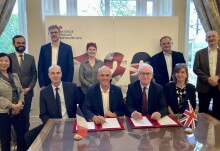

Five teams of engineering postdocs have been awarded funding as part of the Dame Julia Higgins Engineering Postdoc Collaborative Research Fund.
Earlier this year, the Faculty gave postdocs some funds from the Dean's Fund to run a collaborative research initiative. From the 34 applications received, the selection committee has decided to fund five proposals, totalling £16,075. The successful bids include:
Javier Andrew-Perez, Enrico Franco and Riccardo Secoli (Computing and Mechanical Engineering)
The project will study the characterization of the physiologic essential tremor in the upper arm caused by various neurological disorders, including Parkinson's Disease.
Control methods for adaptive tremor cancellation will then be investigated and integrated in robot-assisted rehabilitation exercises, in order to improve the smoothness of gross motions. A pilot study will assess the short-term benefits of tremor-cancellation in robotic-assisted rehabilitation on PD patients.
Andrew Ballantyne and Richard van Arkel (Materials and Mechanical Engineering)
The project proposes the use of deep eutectic solvents for the electropolishing of additive manufactured titanium scaffolds. This will remove manufacturing defects using benign chemicals, unlocking the potential of 3D printed titanium structures as bone mimics in the human body to assist treatment of osteoarthritis.
Janice Kenney, Jonathan Ritson and Hannah Rigby (Earth Science and Civil Engineering)
The project aims to identify pharmaceutical compounds present in biosolids applied to agricultural soil that pose a potential risk to the environment or to drinking water sources, and to examine their potential mobility in sewage sludge-soil systems.
Nicolas Newell, Spencer Barnes and Deborah Adkins (Bioengineering, Mechanical Engineering and Dyson School of Design Engineering)
The project will work towards the design of a surrogate lumbar spine that can be attached to the Hybrid-III anthropometric test device to increase its biofidelity and help assess injury risk during under vehicle explosions.
Kamaljit Singh and Deborah Adkins (Earth Science and Dyson School of Design Engineering)
The project will use biomimetics (imitation of models, systems and natural elements) to design green buildings for the modern built environment.
The project takes its inspiration from the design of termite mounds, where micro-porous structures and controlled thermal conductivity could help provide new ways to construct energy efficient buildings.
Each of the successful applicants will report back on their progress next year.
Article text (excluding photos or graphics) available under an Attribution-NonCommercial-ShareAlike Creative Commons license.
Photos and graphics subject to third party copyright used with permission or © Imperial College London.
Reporter

Sean Conner
Faculty of Natural Sciences

Contact details
Email: s.conner@imperial.ac.uk
Show all stories by this author



